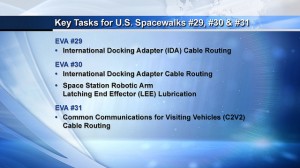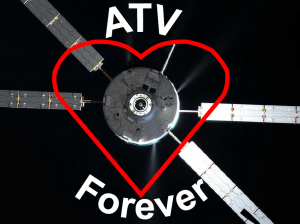Change of command on the ISS

Watch the replay of the handing over here:
[youtube bsd3oOKIBLM]
10/03/2015


Watch the replay of the handing over here:
[youtube bsd3oOKIBLM]
10/03/2015
After 91 days of living in their new home in space they finally went outside Not to catch some fresh air of course…that would be quit dangerous!
US astronauts Barry Wilmore and Terry Virts commenced the first of three spacewalks last Saturday. It was Barry’s second spacewalk after his first one last October and Terry’s first.
The two astronauts, already nicknamed the ‘cable guys’ have to rig cables on the International Space Station for new docking ports for commercial and international spacecraft called International Docking Adapters or IDA. They will be delivered on two Space-X Dragon spacecraft in the near future.
The adapters are built by Boeing and will arrive separately as Dragon cargo that will dock to the Harmony Module or Node 2. Node 2 already has two Pressurized Mating Adapter (PMA) which are used to connect spacecraft and modules with different docking mechanisms. They resemble tunnels that connect to spacecraft.

The tasks for the U.S. spacewalks #29, #30, #31.
The goal will then be to link each International Docking Adapters to a Pressurized Mating Adapter … imagine doing it with Lego, more or less!
But like with Lego there is a possibility that one piece, in this case the Pressurized Mating Adapter could be better used elsewhere. That is the case with PMA-3. The first International Docking Adapter is relatively easy to install: it is connected to PMA-2, which is installed on the Harmony Module facing the direction the Space Station moves.
The second International Docking Adapter requires more work. The international adapter will be connected to PMA-3 but it first has to be moved from Node 3 Harmony to Node 2 Unity to face towards space.
Why all this work? The new docking adapters will be used to welcome the new commercial cargos from Space-X and Boeing , starting most likely from the last part of 2017. In the long run the two new Adapters will allow the Space Station to host one more crew from the present six.
In the meantime new cargo arrived at the Space Station bringing food, supplies and new hardware for the experiments.
It has been a busy period for the astronauts living on the ISS that in a very short period has seen the arrival of Dragon and the depart of both Dragon and the last ever European cargo spaceship ATV-5. Progress 58, the Russian cargo just arrived at the Station, will stay docked to the Station until next August.
The astronauts have a lot of work to do in any case: two more spacewalks are expected this week and a new crew will soon arrive to start Expedition 43.
Stefano Sandrelli
Cover image: Terry Virts as seen from the Cupola of the ISS and photographed by Samantha Cristoforetti on Feb.21, 2015. Credits: ESA/NASA
For more pics of the U.S. spacewalk #29: https://www.nasa.gov/mission_pages/station/expeditions/expedition42/gallery.html#.VOtMxvmG-So
23/02/2015
Research has shown that a more acidic diet seems to decrease the mineral content of your bones. This is in particular of interest for people who are inactive and have a lower mineral bone density. This is also of importance for astronauts during their missions since astronaut bones already have less loading in space so they suffer from reduced bone mineral density.
One might think that the potential renal acid load derives from the acids in the food we eat. The main nutrients affecting the acid load of a diet are protein, calcium, potassium, phosphorus and magnesium. An algorithm to calculate the potential renal acid load (PRAL) was developed by Remer & Manz (J Am Diet Assoc 1995). They took into account the absorption rates of nutrients in the gastrointestinal tract as well as the metabolic processes in the body
PRAL (mEq/d) = 0.49 * protein (g/d)
+ 0.037 * phosphorus (mg/d)
– 0.021 * potassium (mg/d)
– 0.026 * magnesium (mg/d)
– 0.013 * calcium (mg/d)
The information needed to calculate a PRAL is often found on food packaging. Another way is to take information from tables of nutritional values. Precalculated PRALs are available such as www.saeure-basen-forum.de/pdf/IPEV-Food_table.pdf. To calculate the total PRAL of a meal you just add the food items together.
Food that is high in protein content, such as meat, fish, milk or cereals are acidic while vegetables and fruits are generally more alkaline because of their high potassium content. Meat lovers are highly recommended to combine meat with large portions of vegetables or fruits to compensate for the acidity from meat’s high protein content.
Martina Heer
23/02/2015
The most important effects of microgravity on the human body are losing bone density and deteriating muscle strength. Each astronaut on the International Space Station exercises 150 minutes every day in the “space gym” to minimise the effects of living in space. Astronauts can use several exercise machines to simulate training on Earth. One of these is the Advanced Resistive Exercise Device or ARED for friends. We asked ESA astronaut Samantha Cristoforetti to show and explain how ARED works…ready?
[youtube 87YxeKTv8Y8]
20/02/2015
Time for farewells!! The Dragon spacecraft left the International Space Station earlier this week and today ESA’s ATV spaceship with the catchy name Georges Lemaître detached from the Station and will plunge after several orbits into Earth’s atmosphere. Due to the enormous heat from friction caused by its deceleration through the upper layers of air layers the spacecraft will turn into a huge fireball – a fitting end to the spacecraft that is named after one of the founding fathers of the Big Bang theory!
Unfortunately, this will be the last ATV – after five very successful missions, the project is now complete. At the Columbus Control Center (Col-CC) we provided for each flight the ground infrastructure and supplied our colleagues at ATV Control Centre in Toulouse, France, with data, video and voice connections to the International Space Station network. After ESA astronaut Samantha Cristoforetti and cosmonaut Alexander Samokutyaev closed the hatches of ATV yesterday, the Space Station was prepared for the last hours of undocking of ATVs. We turned off our little amateur radio station [https://www.ariss.org/] in Columbus as well as the external Rapidscat experiment [https://www.jpl.nasa.gov/missions/iss-rapidscat/], any radio interference with ATV’s navigation from the International Space Station should be avoided.Slowly the Space Station turned to an appropriate orientation for undocking. When the moment arrived the Space Station’s active position control was turned off completely: Georges Lemaître needs to push away from the Space Station without the mothership trying to compensate for this force.
Afterwards all that remained was for the astronauts to wave good-bye …
 ATVs are part of a large space fleet that supplies the International Space Station. When the American Space Shuttle withdrew from service the Russian Soyuz spacecraft became the only way to get people to the Space Station and back on Earth. Three astronauts share a small space – and so there is little room for other supplies.
ATVs are part of a large space fleet that supplies the International Space Station. When the American Space Shuttle withdrew from service the Russian Soyuz spacecraft became the only way to get people to the Space Station and back on Earth. Three astronauts share a small space – and so there is little room for other supplies.
Tom Uhlig, Columbus Flight Director at the DLR center in Oberpfaffenhofen/Germany
Cover image by ESA astronaut Samantha Cristoforetti: https://www.flickr.com/photos/astrosamantha/16546104212/ .
16/02/2015
Stefano Sandrelli
To learn more about the Epigenetics experiment: https://www.nasa.gov/mission_pages/station/research/experiments/1075.html Cover image: Caenorhabditis elegans — a millimeter-long roundworm with a genetic makeup scientists understand — will be central to a pair of Japan Aerospace Agency investigations into muscle and bone loss of astronauts on the International Space Station in the first few months of 2015. Image Credit: NASA06/02/2015
Variation, variation and more variation: this is the correct way to ensure we eay all the nutrients that our body needs. For this reason the one dish meal helps us make every meal as complete as possible: 50% of your carbohydrate intake should come in fruits or vegetables, while 25% of your carbohydrate intake should come from whole grains and the last 25% should come from protein. As a condiment you can use extra-virgin olive oil. Proteins can be of animal or vegetable origin. To make your diet as varied as possible it is good to alternate animal proteins with vegetable ones. Meat, fish and eggs bring all the necessary amino acids to the body for its proper functioning. Since meat and eggs are also high in fat, it is good to alternate them with vegetable proteins from greens. Beans, lentils, chickpeas, peas and other vegetables, especially when dried, are important sources of protein as well as containing other properties such as a high fibre content. While it is true that plant proteins have a high biological value, but you can complement the intake of amino acids via the one dish meal scheme, accompanying vegetables with whole-grain products that contain proteins. Let’s make greens a central component of our daily diet! Filippo Ongaro Read more: https://www.filippo-ongaro.it/
03/02/2015
In the second half of the 20th century the global consumption of meat increased fivefold, from 45 million tonnes consumed in 1950 to 250 million tonnes nowadays. The Food and Agriculture Organization estimates meat consumption is expected to double by 2050.
Today, in industrialized countries people consume an average of 224 g of meat per capita per day (over 81 kg per person per year) compared to an average of 30 g (almost 11 kg of meat a year per person) consumed in Africa.
Figures related to the animals slaughtered each year are exorbitant. 58 000 million chickens are slaughtered annually worldwide, 11 000 million in China and 9000 million in the United States alone. If you take other species into account, the numbers are still high: 1383 million pigs; 517 million sheep; 430 million goats; 296 million cows… In recent years, the consumption of meat has increased in China, India and most countries where a new middle class is emerging coupled with demographic growth.
Increased worldwide demand results in a massive growth of industrial production of meat and, therefore, concentration of power in the hands of a few large companies that can meet market demand. This transformation of the livestock sector and meat production has a long series of negative consequences on the environment, animal welfare, social equality as well as the health and quality of human life.
Everyone can contribute to improve the situation and change this trend however. For example you can: consume less meat; buy better quality; vary the species and races of animals you eat; choose different cuts; be wary of low prices; favour meat from locally-bred animals and avoid imported products as much as possible; learn to read product labels; consider animal welfare; ; be curious and ask your butcher for more information or visit a farm to see how animals are raised.
Finally remember that giving up some things often has an up-side: eating less meat is not a punishment, your health will benefit and so will the environment and animal welfare. “Replace” meat with tasty, seasonal food and you will not even miss it!
Silvia Ceriani
For years, Slow Food is trying to raise awareness among consumers about eating better quality and less meat. This year, from 4 to 6 June, the international event Slow Meat will be held in Denver on this subject (https://www.slowfoodusa.org/slow-meat-2015), it is organised by Slow Food USA. To know more about Slow Food, click here: (https://www.slowfood.it/quanta-carne-mangiamo/).
30/01/2015
The term protein synthesis refers to the biochemical process through which the genetic information in DNA is converted into proteins that perform biological functions in the body. A process called transcription froms a strand of messenger RNA from DNA as a mold for the production of a protein. Protein synthesis is part of a complex series of metabolic reactions that, by consuming energy, form complex molecules from simpler ones to repair and rebuild damaged tissues. The opposite reactions that degrade complex molecules thereby releasing energy are called catabolic. Metabolism is characterized by a continuous succession of catabolic and anabolic reactions which vary depending on age, nutrition and environment . Because our bodies synthesis protein in a regular and orderly manner it is necessary to provide the body with sufficient amounts of raw material, that is to say, dietary protein that will provide the necessary amino acids to turn into proteins. The amount of dietary protein varies according to the level of physical activity, and ranges from a minimum of 0.8 g per kg body weight for a sedentary person, up to 2 g for fit and powerful athletes. Furthermore, anabolic reactions are regulated by a number of hormones including insulin, growth hormone and testosterone which are influenced by food intake, type of physical activity and by the time between activity and recovery. During a long space mission it is essential to continue stimulating protein synthesis to minimize catabolic reactions that load the muscle and bones. A balanced diet that ensures enough protein and a daily exercise program that offers intensive use of muscles with special tools to simulate weight training, logically impossible in orbit.
Dr. Filippo Ongaro
Read more: https://www.filippo-ongaro.it/
29/01/2015
When it comes to muscles people often think of the sculpted bodies of athletes or bodybuilders.
But muscles are necessary to us all, just as the heart, brain, skin and bones, and we all have them. Few people know however, that after the age of 35, our muscle mass will decrease by up to 1% each year. Once you reach the age of 75 years old if nothing is done to slow this process, you may find yourself with 40% less muscle mass! This muscle loss causes a loss of strength and autonomy that iss very often the basis of the downward spiral that leads to frailty of old-age that is marked by weakness, loss of balance and difficulty leaving home. In turn this can lead to psychological changes that lead to isolation and consequently even the slowing down of cognitive functions. Muscles health is not the only factor of course but remember that strong and healthy muscles help regulate glycaemia, blood pressure and even mood. Muscles help keep strong bones and this is why they are a central aspect being in good health. There is no need to engage in extreme activities to avoid this downward spiral but make some space in your weekly routine for some training with weights or resistance bands or a simple workout coupled with a healthy dose of aerobic activity such as walking, running, swimming or cycling. Remember that to maintain healthy muscles you need to absorb adequate protein by eating fish, vegetables and lean meats. If working out for cosmetic reasons is not your thing, before you dismiss exercise outright, remember that more muscle equals longer life. Dr. Filippo Ongaro to learn more: https://www.filippo-ongaro.it/ In the cover image: ESA astronaut Thomas Pesquet training on the Advanced Resistive Exercise Device at NASA Johnson Space Center’s Columbia Center, 16 September 2014.29/01/2015